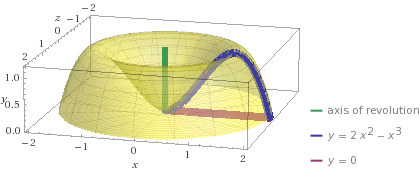How do you find the volume of the solid generated by revolving the region bounded by the curves #y=2x^2 -x^3# and y = 0 rotated about the y-axis?
1 Answer
This is what you will be revolving.
graph{2x^2 - x^3 [-0.1, 10, -0.3, 5]}

What we could do here is use the shell method, which is far more convenient in this case than the traditional revolution method.
where:
Now where is the x-intercept? We can see it's
So we have:

